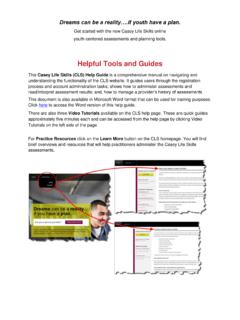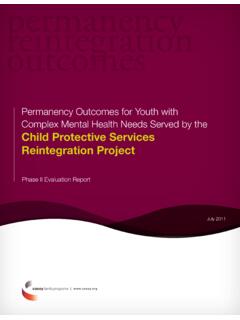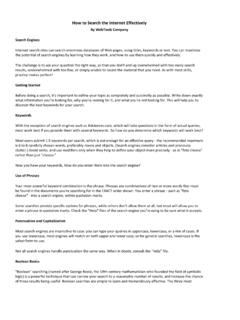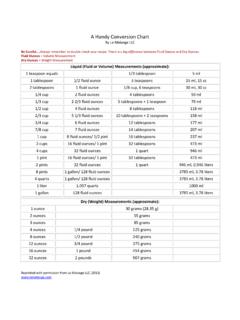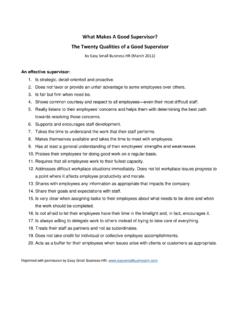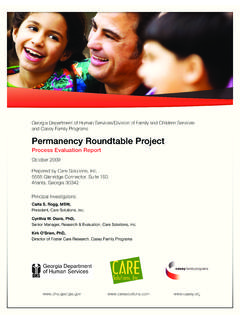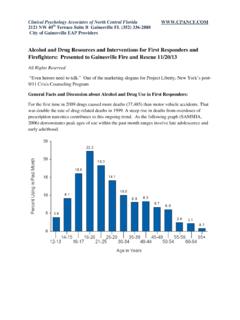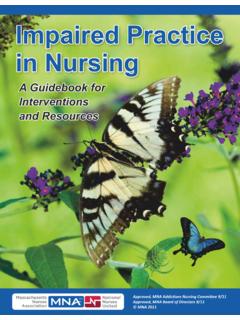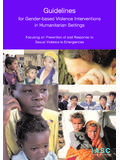Transcription of Levels of Research Evidence and Benefit-Cost Data for ...
1 Levels of Research Evidence and Benefit-Cost Data for Title IV-E Waiver interventions Research Brief (Third Edition) UPDATED OCTOBER 2015 2 Table of Contents I. Introduction ..3 II. Title IV-E Demonstration Intervention Summaries for Programs with Benefit-Cost Data ..5 III. Benefit-Cost Data for Title IV-E Waiver Practice Strategies .. 14 IV. Waiver Program interventions That Have Evidence of Effectiveness but Where We Could Not Find Any Benefit-Cost Data .. 24 V. Waiver Program interventions That Are Stated in General Terms or the interventions Do Not Yet Have Substantial Evidence of Effectiveness and Benefit-Cost Data.
2 25 VI. Conclusions .. 26 Appendix A .. 27 VIII. Endnotes .. 41 Copyright. 2015 Casey Family Programs. All rights reserved. Compiled by Peter J. Pecora, , Kirk O Brien, , and Erin J. Maher, , Research Services, Casey Family Programs. The State Title IV-E demonstration interventions were abstracted from what is publicly available on the ACF website and supplemented by recent state summaries. For related reports, see Special thanks to the Title IV-E Child Welfare Demonstration Project leaders from each jurisdiction who reviewed the summary for their state or county.
3 3 I. Introduction Overview Child welfare services are concerned with three main areas: child safety, permanency, and well-being. The primary goal is to protect children from harm. The second goal is to preserve existing family units, which include birth families or relative families, as appropriate. Helping youth achieve a form of legal and psychological permanence, however, may require a variety of permanency planning alternatives such as family reunification, placement with relatives, different forms of guardianship (depending upon local law), and adoption.
4 The third goal focuses on promoting children s development into adults who can live independently and contribute to their Given these goals, we need to curb the rescue mentality that has traditionally influenced child welfare systems to treat the issue of child safety in isolation from all of the other challenges facing at-risk families. Further, we need to limit the view that the challenges families are facing can be treated in isolation from the conditions of the communities in which they live.
5 Child welfare services are concerned with not only long-term child outcomes ( , self-sufficiency, healthy parenting, employment, education, and avoiding incarceration) but fostering healthy communities that support families. Thus, the child welfare service population is both at-risk families and the communities in which they System reform strategies in the areas of practice, administration, and policy have changed the conditions for maltreated children and have accelerated permanency planning.
6 Thereby safely reducing the number of children in foster Some of these strategies have used Evidence -based practices that show how the money can be allocated differently to be more effective in creating better futures and outcomes for children in at-risk families. cost -savings resulting from foster care reductions and other program reforms need to be reinvested in high-quality and proven services for the parents and children who need services whether in- or out-of-home, especially in times of fiscal Yet the restrictions on certain funds challenge child welfare agencies to leverage their resources in this way.
7 So, how do we better invest existing funds to address the issues listed above? How can child welfare agencies pay for innovations and interventions with known effectiveness to improve community, family, and child outcomes?5 Section 1130 of the Federal Social Security Act, enacted in 1994, gave the Secretary of Health and Human Services (HHS) the authority to approve waivers to Title IV-E rules for the purpose of funding demonstration projects in state or county child welfare systems. This authority provides an opportunity for states and tribes that administer Title IV-E funding to use the funds more flexibly in order to test innovative approaches for child welfare service delivery and financing.
8 Across the country, Title IV-E Child Welfare Demonstration Projects are expected to document the benefits of a more balanced array of child welfare services. 4 In 2011, Congress reauthorized HHS to approve up to ten waivers per year in federal fiscal years (FY) 2012 through 2014, and it revised certain demonstration project goals and requirements. The HHS administration also highlighted child well-being as a priority area and called for an increase in the use of screening and assessment and Evidence -based well-being With a federally approved waiver, states can design and demonstrate a wide range of approaches to reform child welfare and improve safety, permanency, and well-being outcomes for In FY 2012, HHS approved nine projects in Arkansas, Colorado, Illinois, Massachusetts, Michigan, Pennsylvania, Utah, Washington, and Wisconsin.
9 In FY 2013, the Department approved eight more projects in the District of Columbia, Hawaii, Idaho, Montana, Nebraska, New York, Rhode Island, and Tennessee; and in FY 2014, the department approved nine projects in Arizona, Kentucky, Maryland, Maine, Nevada, Oklahoma, Oregon, Texas, West Virginia one tribal nation (Port Gamble S Klallam Tribe). There are also four waiver extension states: California, Florida, Indiana, and Ohio. Note that in 2015 Montana decided to end their waiver demonstration project.
10 Because of intervention shifts in some states, two interventions are no longer being included in any waiver demonstration: (1) Nurse Family Partnership for Low-Income Families (NFP), (2) Head Start and Early Head Start. This document categorizes Title IV-E demonstration interventions currently being used or proposed by the complete set of Title IV-E Waiver states and counties according to their effectiveness data. Based on a review of existing literature and resources, we have also compiled Benefit-Cost data, when available.
